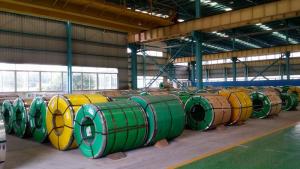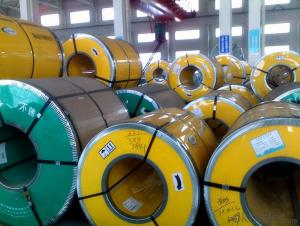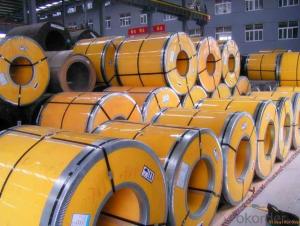Cold Rolled Stainless Steel Coil 304 Grade 2B Finish
- Loading Port:
- China Main Port
- Payment Terms:
- TT OR LC
- Min Order Qty:
- -
- Supply Capability:
- -
OKorder Service Pledge
OKorder Financial Service
You Might Also Like
Cold Rolled Stainless Steel Coil 304 Grade 2B Finish
Packaging Detail:standard export packing or as customer's requirements
Delivery Detail:7-15 days after the order
MOQ: 25mt
Standard: | AISI,ASTM,BS,DIN,GB,JIS | Grade: | 304 | Thickness: | 0.3-3.0mm |
Place of Origin: | China Mainland | Brand Name: | CNBM | Model Number: | 304 |
Type: | Steel Coil | Technique: | Cold Rolled | Surface Treatment: | 2B, BA |
Application: | Medical instruments, building, chemical food industry agriculture | Width: | 500-2000mm | Length: | Coil |
finish: | 2B | item: | 304 cold rolled stainless steel coil | density: | 7.93 |
Cold Rolled Stainless Steel Coil 304 Grade 2B Finish
Chemical composition: |
| ||||||
C | Si | Mn | Cr | Ni | S | P | |
≤0.07 | ≤1.0 | ≤2.0 | 18.0~20.0 | 8.0~11.0 | ≤0.03 | ≤0.035 | |
mechanical properties: |
| ||||||
Tensile strength σb (MPa) | Conditions yield strength 0.2 sigma (MPa) | Elongation δ5 (%) | Section shrinkage (%) | Hardness | |||
520 | 205 | 40 | 60 | ≤1 | |||
- Q:Can stainless steel strips be used in outdoor applications?
- Yes, stainless steel strips can be used in outdoor applications. Stainless steel is highly resistant to corrosion and rust, making it suitable for various outdoor environments. It can withstand exposure to moisture, rain, and extreme temperatures, making it an ideal choice for outdoor construction, architecture, and other applications.
- Q:Can 111 stainless steel strips be formed into wire for various applications?
- Yes, 111 stainless steel strips can be formed into wire for various applications. Stainless steel strips can undergo a process called wire drawing, where they are pulled through a series of dies to reduce their diameter and form them into wire. This wire can then be used for a wide range of applications such as electrical wiring, springs, cables, and more.
- Q:Can stainless steel strips be used in the electronics industry?
- Yes, stainless steel strips can be used in the electronics industry. They are commonly used for various applications such as grounding straps, shielding, connectors, and enclosures due to their corrosion resistance, mechanical strength, and electrical conductivity.
- Q:Are stainless steel strips suitable for architectural facades?
- Yes, stainless steel strips are suitable for architectural facades. Stainless steel is a highly durable and corrosion-resistant material, making it ideal for exterior applications. It has excellent strength-to-weight ratio, allowing for versatile design possibilities. Stainless steel strips can be easily fabricated into various shapes and sizes, enabling architects to create unique and visually appealing facade designs. Additionally, stainless steel's reflective surface can enhance the aesthetics of a building, especially when used in conjunction with other architectural elements. Furthermore, stainless steel is low maintenance, requiring minimal cleaning and upkeep, which is advantageous for long-term durability and cost-effectiveness. Overall, stainless steel strips are a reliable and versatile material choice for architectural facades.
- Q:What are the common uses of stainless steel strips in the kitchen?
- Stainless steel strips are commonly used in the kitchen for various purposes such as making utensils, cutlery, and cookware due to their durability, corrosion resistance, and easy maintenance. They are also used for creating kitchen appliances like refrigerators, dishwashers, and ovens, as well as for constructing countertops, backsplashes, and sinks. Additionally, stainless steel strips are employed in the fabrication of shelving, storage racks, and other organizational systems in the kitchen.
- Q:Can stainless steel strips be customized?
- Yes, stainless steel strips can be customized to meet specific requirements, such as size, shape, finish, and thickness. Customization options allow for greater versatility and adaptability of stainless steel strips in various applications.
- Q:What are the factors affecting the abrasion resistance of 111 stainless steel strips?
- The abrasion resistance of 111 stainless steel strips can be influenced by several factors. To begin with, the composition of the stainless steel itself plays a crucial role. The percentage of key elements like chromium, nickel, and molybdenum can impact the steel's hardness and toughness, thus affecting its resistance to abrasion. Generally, higher levels of these elements result in increased abrasion resistance. Additionally, the microstructure of the stainless steel is important. Factors such as the presence of grain boundaries, phase transformations, and precipitates can influence the steel's ability to withstand abrasion. It is generally preferred to have a fine-grained microstructure for improved abrasion resistance. The surface finish and treatment of the stainless steel strips also have a significant impact. Processes like polishing and passivation can enhance the smoothness of the surface, reducing the likelihood of abrasion. Moreover, applying protective coatings such as ceramic or diamond-like carbon can provide an extra layer of defense against abrasion. The mechanical properties of the stainless steel, including hardness and tensile strength, also affect its resistance to abrasion. Harder materials tend to be more resistant to abrasion as they can withstand the forces and friction involved. Similarly, higher tensile strength helps the material withstand deformation and wear. External factors, such as the type and intensity of the abrasive material, the speed and pressure of the abrasion, and the temperature and humidity conditions, can also impact the abrasion resistance of stainless steel strips. Different abrasive materials have varying levels of hardness and sharpness, which can affect the wear rate. Higher speeds and pressures can increase the severity of abrasion, while elevated temperatures and humidity levels can promote corrosion and wear. In conclusion, the abrasion resistance of 111 stainless steel strips is influenced by a combination of factors, including material composition, microstructure, surface treatment, mechanical properties, and external conditions. Understanding and optimizing these factors can assist manufacturers and users in selecting and utilizing stainless steel strips that are most suitable for their intended applications.
- Q:Can stainless steel strips be used in extreme temperature conditions?
- Stainless steel strips are capable of being used in extreme temperature conditions. This material is versatile and durable, able to endure a wide range of temperatures. Its exceptional heat resistance properties make it suitable for both high and low-temperature environments. Stainless steel strips maintain their structural integrity and mechanical properties even under intense heat. They also exhibit remarkable resistance to thermal expansion and contraction, ensuring stability in extreme temperature conditions. Moreover, stainless steel has excellent resistance to corrosion, oxidation, and scaling, making it an excellent choice for applications that involve temperature fluctuations and exposure to harsh environments. In conclusion, stainless steel strips are a dependable and efficient option for various industries that require materials capable of withstanding extreme temperatures.
- Q:How do you store stainless steel strips?
- To store stainless steel strips properly, it is important to take certain precautions to prevent damage and maintain their quality. Here are some recommended steps to follow: 1. Clean and dry: Before storing stainless steel strips, make sure they are thoroughly cleaned and dried to remove any dirt, dust, or moisture. This will prevent corrosion or staining during storage. 2. Protect from moisture: Stainless steel is susceptible to rust, so it is crucial to keep the strips away from moisture. Store them in a dry and well-ventilated area, away from any water sources or high humidity environments. 3. Avoid contact with other metals: To prevent potential galvanic corrosion, avoid storing stainless steel strips in direct contact with other metals, especially those that are less noble or prone to corrosion. If stacking the strips, consider using separators or protective layers made of plastic or non-reactive materials to prevent direct metal-to-metal contact. 4. Use proper packaging: To provide additional protection, consider packaging the stainless steel strips in appropriate materials such as plastic wrap, paper, or specially designed corrosion-resistant packaging. This will help prevent scratches, corrosion, or other damage during storage or transportation. 5. Organize and label: Properly organize and label the stainless steel strips to easily identify and retrieve them when needed. This will help prevent unnecessary handling and potential damage caused by searching or mishandling. 6. Temperature control: While not always feasible, maintaining a controlled temperature can help prolong the lifespan of stainless steel strips. Extreme temperature variations can cause expansion and contraction, leading to stress and potential deformation. If possible, store the strips in a temperature-controlled environment. By following these guidelines, you can ensure that your stainless steel strips remain in excellent condition and ready for use whenever needed.
- Q:Are 111 stainless steel strips suitable for high-pressure applications?
- High-pressure applications do not find 111 stainless steel strips suitable due to their low-carbon composition, which lacks the required strength and resistance to handle such environments. Instead, it is advised to opt for stainless steel strips of higher grades like 300 series (e.g., 304 or 316) or duplex stainless steels. These alternatives possess superior mechanical properties and corrosion resistance, making them more suitable for high-pressure applications.
1. Manufacturer Overview |
|
|---|---|
| Location | |
| Year Established | |
| Annual Output Value | |
| Main Markets | |
| Company Certifications | |
2. Manufacturer Certificates |
|
|---|---|
| a) Certification Name | |
| Range | |
| Reference | |
| Validity Period | |
3. Manufacturer Capability |
|
|---|---|
| a)Trade Capacity | |
| Nearest Port | |
| Export Percentage | |
| No.of Employees in Trade Department | |
| Language Spoken: | |
| b)Factory Information | |
| Factory Size: | |
| No. of Production Lines | |
| Contract Manufacturing | |
| Product Price Range | |
Send your message to us
Cold Rolled Stainless Steel Coil 304 Grade 2B Finish
- Loading Port:
- China Main Port
- Payment Terms:
- TT OR LC
- Min Order Qty:
- -
- Supply Capability:
- -
OKorder Service Pledge
OKorder Financial Service
Similar products
New products
Hot products
Related keywords































